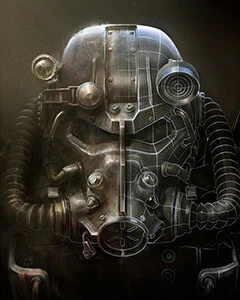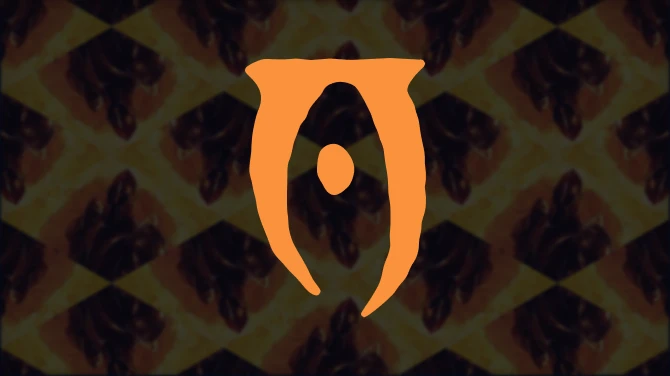
It's that time again! In what is likely to be the final development diary for my Mutant Menagerie series, we dive into the final expansion/iteration of my mad science project for Fallout 4. This project has proven to be a massive undertaking, but also an amazing adventure. And as it turns out, the home stretch is the longest and toughest of them all. I probably should have never taken on an experiment so large as Mutant Menagerie as a solo mod project, but here we are! And, despite all the odds, the end is finally in sight.
I realize that I've gone relatively dark for some time since Nuclear Safari dropped - only jumping in to deliver the End-of-Year Announcement for Mutant Menagerie back in December. This doesn't mean I've abandoned my mod or slacked on my workflow. In fact, it's been quite the opposite! Usually, I'll take a long break from modding after each release - using a few months to work on other things and stay attentive to my mods' comment sections. This time around, however, I started working on the final iteration of Mutant Menagerie shortly after Nuclear Safari's release.
I knew exactly what I wanted the scope to be for this project, and understood that this was going to take a whole lot in the way of time and effort. I wanted to expand and finalize everything I'd been building and iterating on since I started the project back in 2019. And when I say everything, I mean EVERYTHING. All the knowledge I've gained, all the feedback I've gotten, it's all been getting poured into this last giant effort. But what exactly do all the fluff and buzzwords actually mean?
It means that it is far easier to list what HASN'T been changed or improved in some major way than it is to list what has. IE: don't expect a changelog in Life Finds a Way. So let's dive into some of the big features and changes that you can expect to see in Mutant Menagerie: Life Finds a Way!
All-In-One, and One-For-All
Mutant Menagerie: Life Finds a Way is, at its core, the final version of Mutant Menagerie. It includes all expansions and updates rolled into one ESM (minus Backwater Beasts, which will be included as an optional add-on) with an ESL plugin that handles the scripts and any (strictly necessary) vanilla edits. What this means is that all the content I've released thus far will be unified into a single, seamless package. Stitching this all together was the first big step for the mod.
The second big step has been a full overhaul and rebalance of all of the mods' existing content. I've learned a lot about Fallout 4's game balance, where my mod's original philosophy succeeded in improving the game, and where the mod made things worse. The original goal was to add a RDR2-style hunter-gatherer system that could completely replace the dungeon crawl/junk scavenging system from the vanilla game. In short, I wanted an entirely separate gameplay loop that players could engage with - allowing them to roleplay a wasteland hunter for a full playthrough without compromise.
While the concept was solid, the execution proved problematic due to my inexperience with Fallout 4's systems and limitations. There were way too many spawns, and the leveled lists were way too saturated. Junk and food items had very low weight, high value, and yielded an immense amount of crafting components. I wanted an ecosystem's-worth of animals to scatter in all directions when the player walked through the wilderness, and I wanted 1-3 solid kills on a hunting trip to supplement a trip to a small dungeon - such as a Super Duper Mart. Unfortunately, the end result was a nasty stutter on lower end systems and far too much loot.
So, Life Finds a Way reimagines Mutant Menagerie with more reasonable spawn counts, lower loot counts, and much more reasonable meat and component yields. Items have more consequential weight values, lower cap values, and rarer items are actually rare in comparison to original MM's RNG. The goal here is to fix vanilla Fallout 4's god-awful creature loot economy, and establish a much more RPG-esque system that emphasizes rewarding the player's time and investment - without rendering the other gameplay loops comparably obsolete. If that sounds like a tough needle to thread, you're right on the money, buckaroo. Thankfully, I have almost two years' worth of data, feedback, and testing to work with - thanks to you, the community!
A recurring theme that you've likely already began noticing with this final version of Mutant Menagerie is an emphasis on RPG systems and progression intended integrate with the rest of Fallout 4. This isn't a realism mod, and it's not interested in transforming Fallout 4 into something it isn't. I wanted to design something that wasn't pretentious in its ambitions. For Life Finds a Way, I wanted a grounded, sandbox RPG system expansion that complements Fallout 4 rather than absolutely transforming it beyond recognition.
Better With Friends
So rebalancing is a step in the right direction, but it's a drop in the bucket when it comes to accomplishing my overall goals. After all, how can the improved loot feel balanced if the vanilla creatures still drop the same boring stuff? Well, as some of you have seen in the beta, I've been addressing this issue with two forms of scripted integration. The first is by creating custom leveled lists for MM loot and injecting them into the vanilla drop tables. The second form involves injecting new creatures into the vanilla creature leveled lists - so they'll spawn alongside similar vanilla creatures. I've been slowly perfecting the spawn rates and smoothing out bugs and oddities - and I'm currently quite happy with how the scripted integration has worked out.
In addition to creatures like wastewolves and rad-shrews appearing alongside their vanilla allies, new variants of vanilla creatures are integrated via scripts as well. Many of these creatures, like new high-level deathclaw variants, help bridge the gap between Mutant Menagerie's more difficult gameplay and vanilla Fallout 4's Weenie Hut Jr.-ified creatures. The end result, I hope, is a much more varied and engaging Fallout 4 - wherein Mutant Menagerie's reach extends well-beyond its original, overworld-relegated limitations. Now you may even find MM creatures in interiors and loot MM items from creatures that previously had nothing of value.
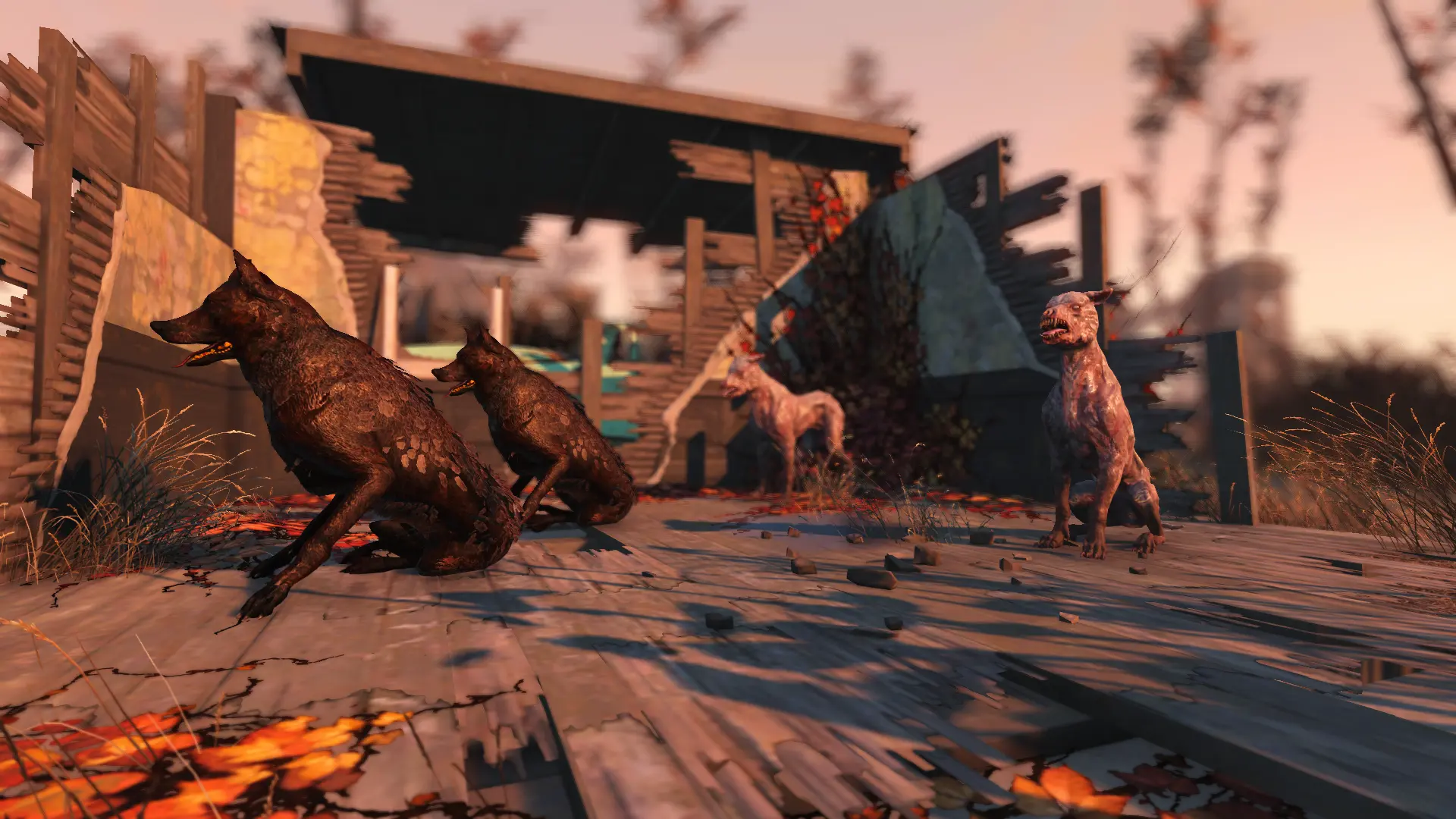
Wild coyotes run with a pack of feral dogs - acting as the rad-shrew to the vicious hound's molerat.
A microcosm of this larger system is the Vault 111 example. In the vanilla game, the dungeon treats you like you've never played a Bethesda game before. It does not challenge the player in any way - it just shows you the ropes. Mutant Menagerie's scripted integration changes this in a few key ways by adding a few new creatures to the radroach leveled lists at level 1. Ants from Nuka-World act as dangerous damage dealers. Like radroaches, they're fragile, but they CAN kill the player with their attacks. They're the outright danger. The second key enemy you'll encounter among radroaches in Vault 111 are baby boombugs. Like radroaches, they don't pack that much of a punch damage wise, but they explode on death - which can instantly kill the player. And since you're relegated to a melee baton for the first half of the dungeon, boombugs present a unique challenge. You can't simply beat them to death - they'll explode! So what do you do? This query has already stumped a fair few players in my comments section that use the scripted integration beta. Since you took the time to dive into my developer diary, I'll let you in on the secret. Did you know all the hallway and room doors in Vault 111 are fully functional? And bugs can't open them once they've been slammed shut.

Thanks to Scripted Integration, new challenges and loot opportunities await in previously familiar and untouched interiors!
This is just one of the ways in which I use new creatures to present unique challenges in vanilla gameplay scenarios. Having to deal with gangs of different creatures that present different challenges in combat is the primary intent here. I don't want to oppress the player with overpowered enemies, so careful consideration is taken when adding new creatures to vanilla leveled lists. The most variety will be found among creatures like feral hounds, bugs, or rats. Essentially, the most common creature factions take priority. The result is a version of Fallout 4 that feels just a bit more unpredictable and interesting compared to the base game. A version where, hopefully, death will be something you actually encounter on a semi-regular basis throughout your playthrough - and not exclusively from gunners with 1600+ HP.

A wastewolf ambushes the player in Far Harbor, leading the charge among a pack of feral wolves.
The Perks of Solid Progress
So, the picture is getting clearer. Much more reasonable spawn counts, better - yet balanced - loot rewards and scarcity, and scripted integration to bridge the gap between Mutant Menagerie and Vanilla. But we're still not there yet. While this all does help to expand pre-established RPG systems in Fallout 4, it doesn't necessarily add anything new to the formula.
Mutant Menagerie's progression has always been a bit… freeform. In the past, it has relied on crafting more difficult recipes and toppling harder enemies to supplement a form of progress. This was a fun way to introduce unique equipment, new crafting materials and recipes, as well as spotlight the toughest creatures in the mod. But - and this is a big but, I cannot lie - the original system did not fully qualify as true progression - especially in a game about leveling up and acquiring perks. It was also open to exploitation.

New Perks, gained by killing specific types of creatures, handle progression in Mutant Menagerie. Not all the perks display as interactive messages when unlocked, though. Ancillary challenge perks, like Lord Death, will display an unintrusive corner message.
In Life Finds a Way, you'll find that this is no longer an issue. There is a wide array of new perks to acquire in Mutant Menagerie, representing a new form of progression for the mod. Much like with Fallout: New Vegas's challenge perks, you'll unlock these new perks by killing certain types of enemies. After meeting the requirement, the perk will be added to the player - giving them a permanent damage bonus and possibly unlocking new tiers of crafting recipes. Progression in Mutant Menagerie is tied to this new perk system.
By hunting and killing various creatures of different archetypes, you will unlock new perk rewards. These perks will not-only provide benefits in the form of increased damage to specific creatures, but they will be tied to the various crafting recipes of Mutant Menagerie. Many crafting recipes, new and old, are locked behind one or more of these perks. To craft the best recipes featured in Mutant Menagerie, you will need to unlock perks through gameplay. This system, similar in concept to the challenge system in Fallout New Vegas, is the backbone of Mutant Menagerie, and acts as its primary progression system. This means that by getting out there and hunting, you'll earn perks that allow you to benefit more from your wasteland harvests. All of this works while ensuring compatibility with other perk mods. Now if you choose to roleplay a wasteland hunter, the game will reward you for doing so - as any good RPG should!
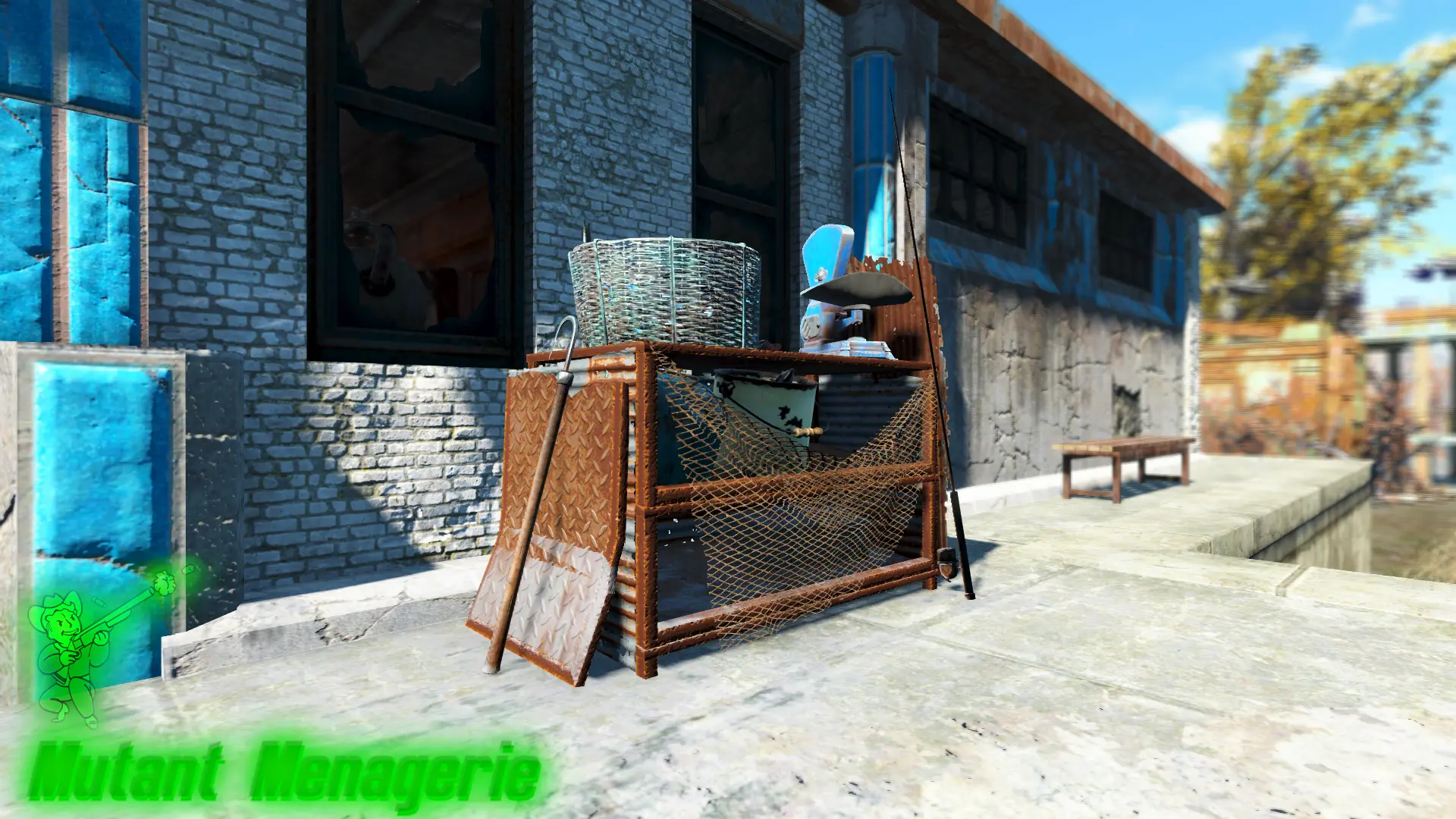
The Fishing Station, one of many new workshop items coming to Mutant Menagerie, can be built with the proper rank of the Extreme Angler Perk - a tiered perk gained by hunting Sea Creatures.
Workshop I: Trophy Hunting
Trophies may not be something most consider when battling the monstrous mutants of the harsh, post-apocalyptic wasteland of Fallout. But in Mutant Menagerie, you can indeed embrace your inner trophy hunter. Life Finds a Way will bring along with it an entire taxidermy system - using the Wasteland Workshop expansion as a base. This includes trophies for all Mutant Menagerie creatures, many variants for those creatures, and trophies for the various world bosses found throughout the world. There are also taxidermy options for vanilla creature variants and DLC creatures and variants , allowing you to truly get in-depth in how you decorate your wasteland hunting lodge. The idea here is to establish a taxidermy system that is much deeper than the one that shipped with the Wasteland Workshop DLC.
You'll be able to mount the heads of mutant creatures and monstrosities on your workshop walls. Gather unique trophies from legendary animals and world bosses and display them for all to see. You can even mount the various fish species you catch while fishing, giving your settlements a truly rustic decorum. The taxidermy system will likely be one of the last systems to be completed for Life Finds a Way, since designing and setting up the trophy meshes can be complicated, and depends on all the creature mesh improvements being finalized.
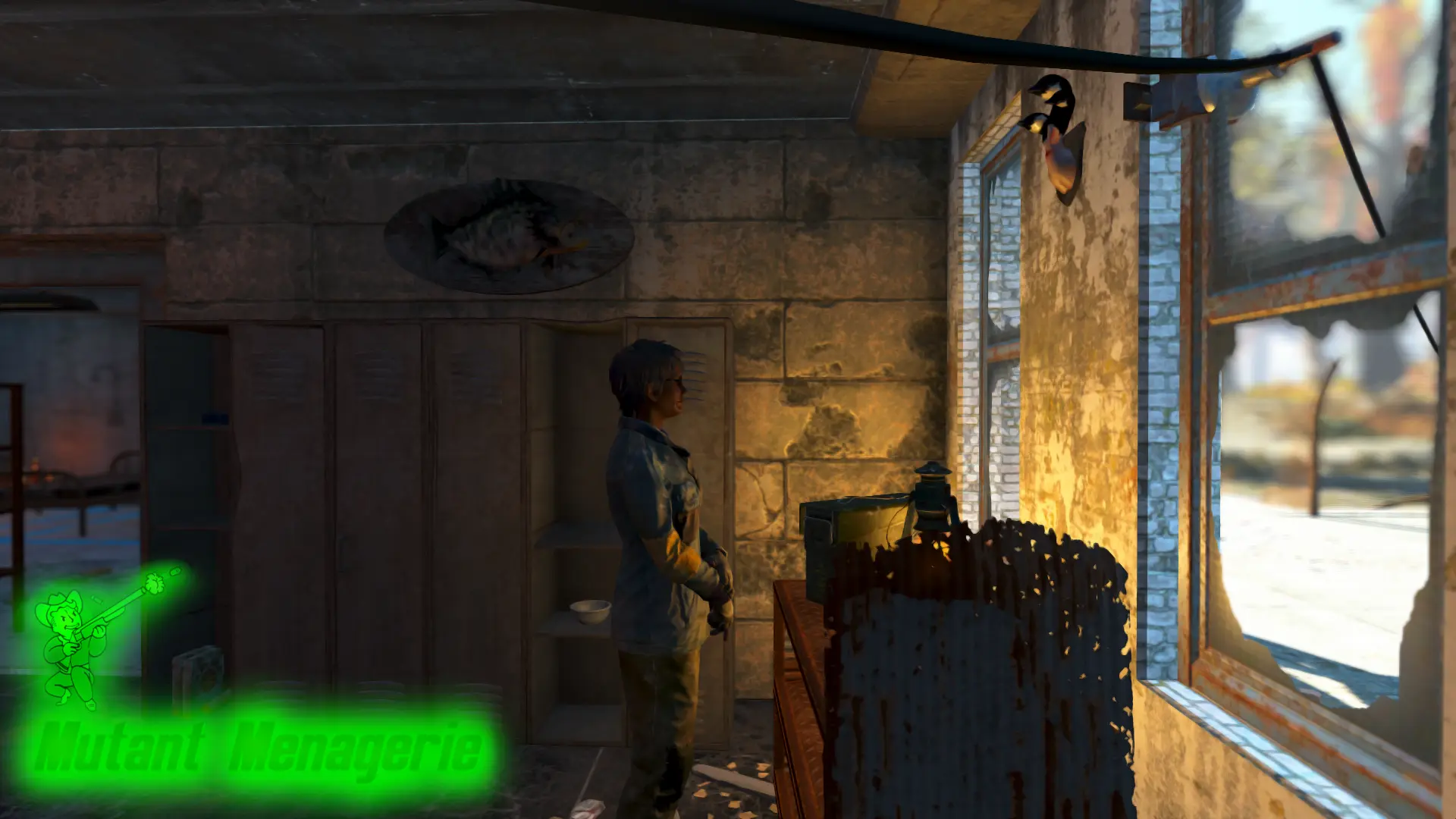
A settler works at a Hunting Station - one of multiple new, Mutant Menagerie-themed scavenging stations, while surrounded by a few of the new workshop trophies!
Workshop II: Caging the Beast
In addition to taxidermy, Mutant Menagerie will also feature a full cage system - covering most Mutant Menagerie creatures. There are two forms of cages with two separate forms of progression - creature cages and traps. Creature cages are exactly what you remember from Wasteland Workshop: a simple cage that catches a variant of a specific creature. These cages require a certain rank of either Animal Friend or Wasteland Whisperer to build them. Traps, on the other hand, will catch a random animal or mutant relative to the trap type. They require one or more of the new hunting perks to craft them.

A Riverlurk emerges from a water-based Mutant Trap - randomized cages that produce a wide variety of mutants when powered.
As you may have guessed, the point to this system is to have trap cages for hunters, and creature cages for beastmasters. Two separate forms of cages with separate purposes and progression. Traps are useful for anyone looking to kill certain categories of creatures in broad strokes without having to go out and hunt them down. Creature cages, on the other hand, give you a variant of a specific creature without any of the guesswork - which is likely more preferable for anyone looking to tame certain creatures.
As a final note on the cage system, DLC creatures now also have their own cages, and many vanilla and DLC creatures are implemented into traps as well. Mutant Menagerie seeks to eliminate the distinction between vanilla, DLC, and modded creatures. In Life Finds a Way, they're all part of one big happy family. This type of integration with vanilla and DLC creatures will be found throughout the entirety of Life Finds a Way - which endeavors to make it difficult for new players to tell which creatures are from the mod, and which were made by Bethesda.

A twig-covered Animal Trap produces an Iguana - for you and your settlers to adopt as your official settlement mascot!
Precision Collision
A big feature of this final version of Mutant Menagerie is the adjustment and fixing of most of the creature models from the mod and its expansions. High-poly models have been optimized, oddities have been corrected, and many creatures have been reshaped and adjusted to better match the vanilla creature models whose animations they are rigged to. Adjustments to the rigs and bone weights also help greatly reduce stretching or animation oddities - which are prevalent in many of the models from the original mod. Additionally, the textures and models of nearly all creatures from the Mutant Menagerie series have seen quality passes. Most creatures have been drastically overhauled, with great care taken to add more detail and substance while retaining the focal points and definition of the original textures.
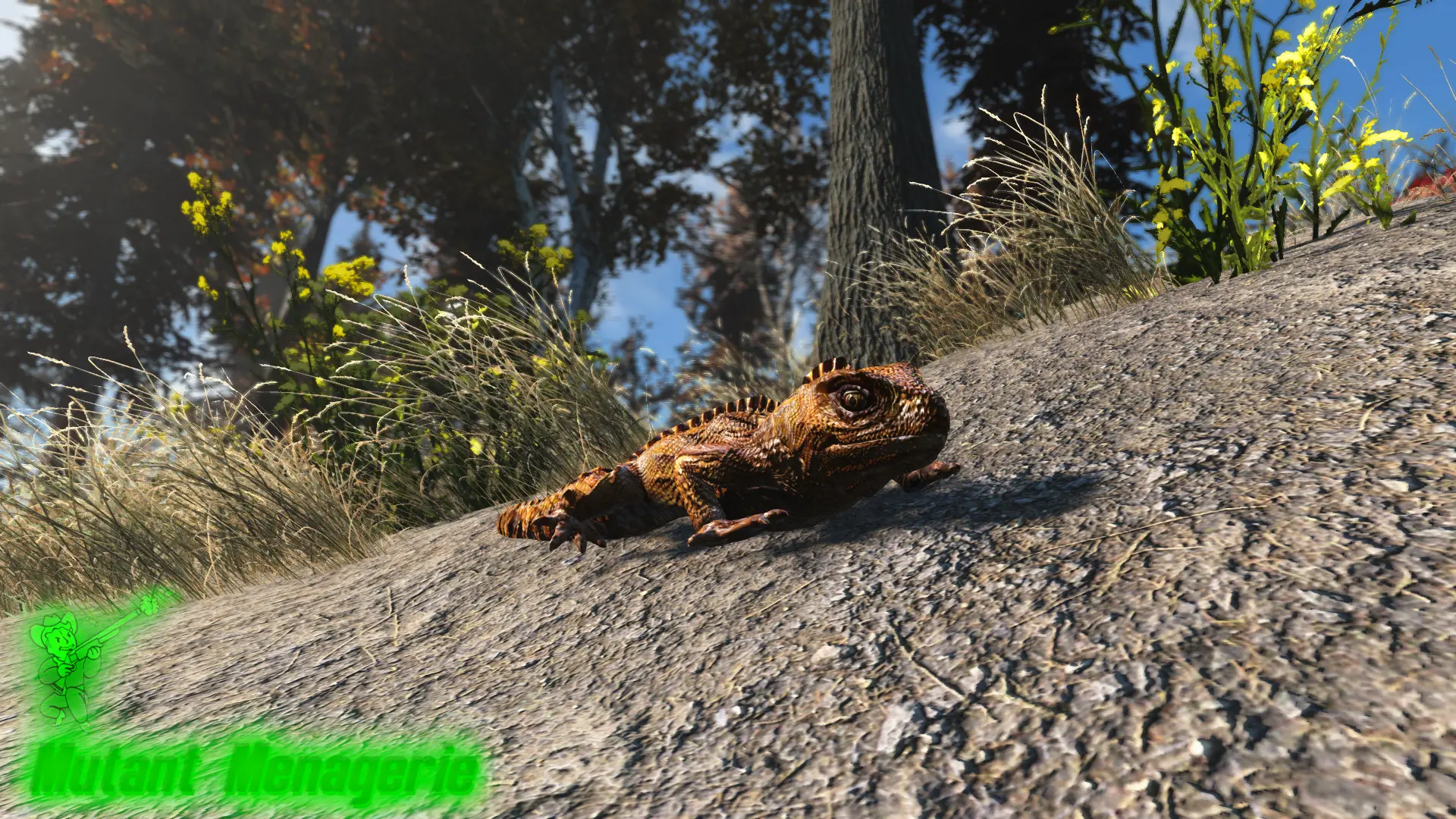
One of the new, overhauled Iguanas found in Life Finds a Way - now available in multiple colors! Compare this new version to the old, outdated version in the screenshot above to see the difference!!
Additionally, the shapes of models have not only been adjusted to better fit the animations, but also to fit the collision. For those who don't know, custom collision for creatures is pretty much impossible in Fallout 4 without the proper tools - which have been discontinued and largely lost to time. So, the best way to ensure accurate collision meshes is to resize and morph all of my creatures to properly fit within the collision meshes of their vanilla counterparts. So, that's exactly what I'm doing. Now - for the most part - you will no longer struggle to hit mutant Menagerie creatures due to parts of their models not matching their collision meshes. An added benefit of resizing and morphing creatures to fit their target collision meshes is that it also greatly reduces model stretching during animations. This, combined with the rig adjustments outlined above, means that most cases of noticeable stretching in the mod have been solved. Many of you were impressed with the lack of stretching in my Nuclear Safari Rigs, and I'm happy to say now all creatures match or approach that level of quality.
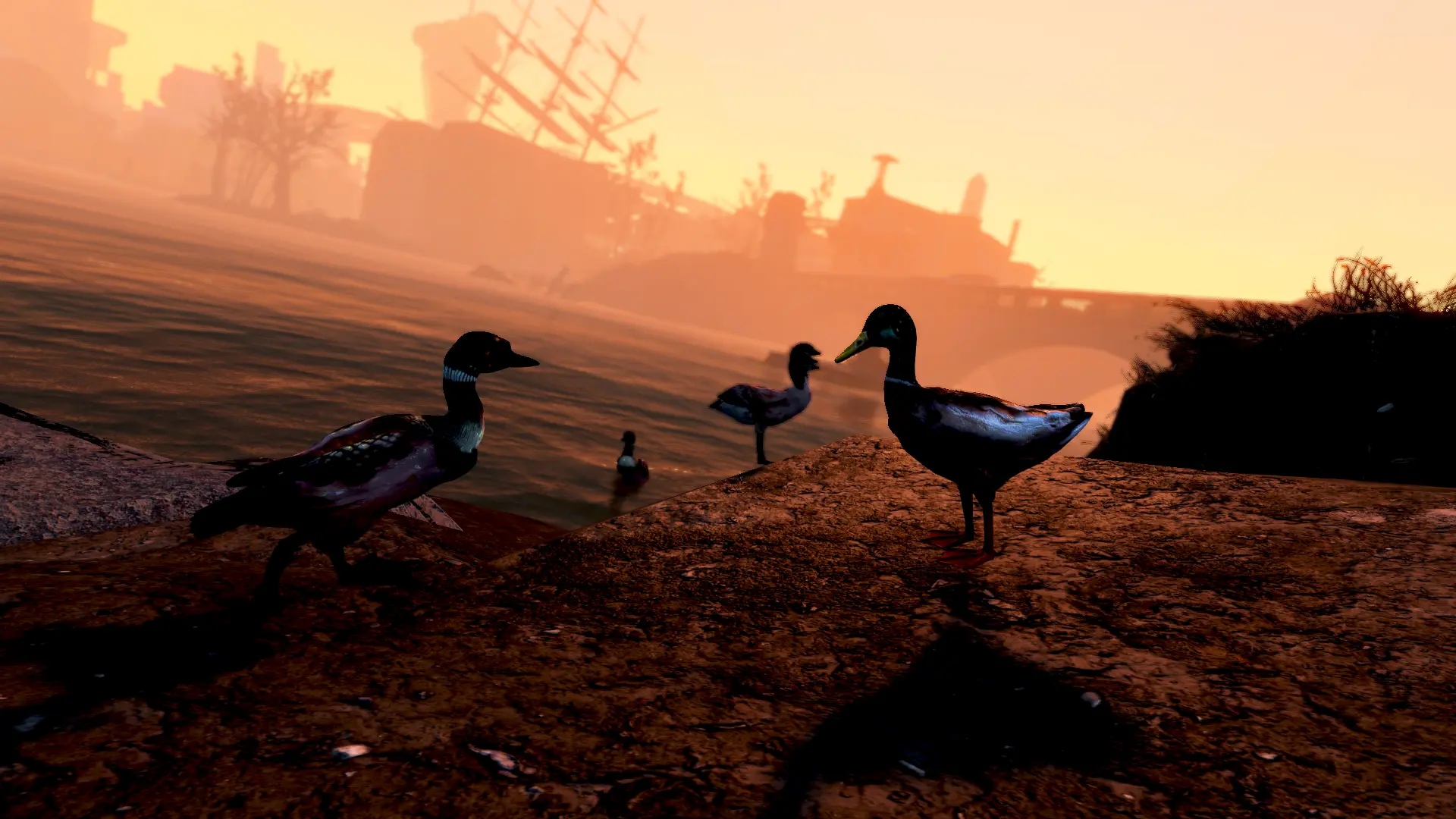
Waterfowl are a prime example of the type of changes you can expect in Life Finds a Way. Stretching has been all-but entirely removed, materials have been improved, and the models now fit within their collision meshes - allowing for precision aiming while hunting.
But what exactly does this look like in practice? Are creatures morphed beyond recognition - #NotMyMutantMenagerie? Well, the new boombugs from the last update of MM - BGH are a great example. Their models are smaller, and their shape matches the collision mesh of the radroach near-perfectly. They may be skinnier - and a bit more roach-like - but you can't argue with the results. I've been systematically adjusting all creatures in this way, and so far the result is much, much smoother gameplay across the board. Certain creatures cannot be fixed further - like the mingo's or giraffe's long necks and heads. These areas will continue to lack collision, because there's simply no creatures in the game with remotely similar models. We do what we can, but we can't work miracles!

Speaking of Boombugs, here they are with their latest meshes and their newest textures and materials! As you can see, they are much more vibrant, their textures are much more detailed, and they much more closely resemble the saturated, shiny ladybugs from nature upon which they are based.
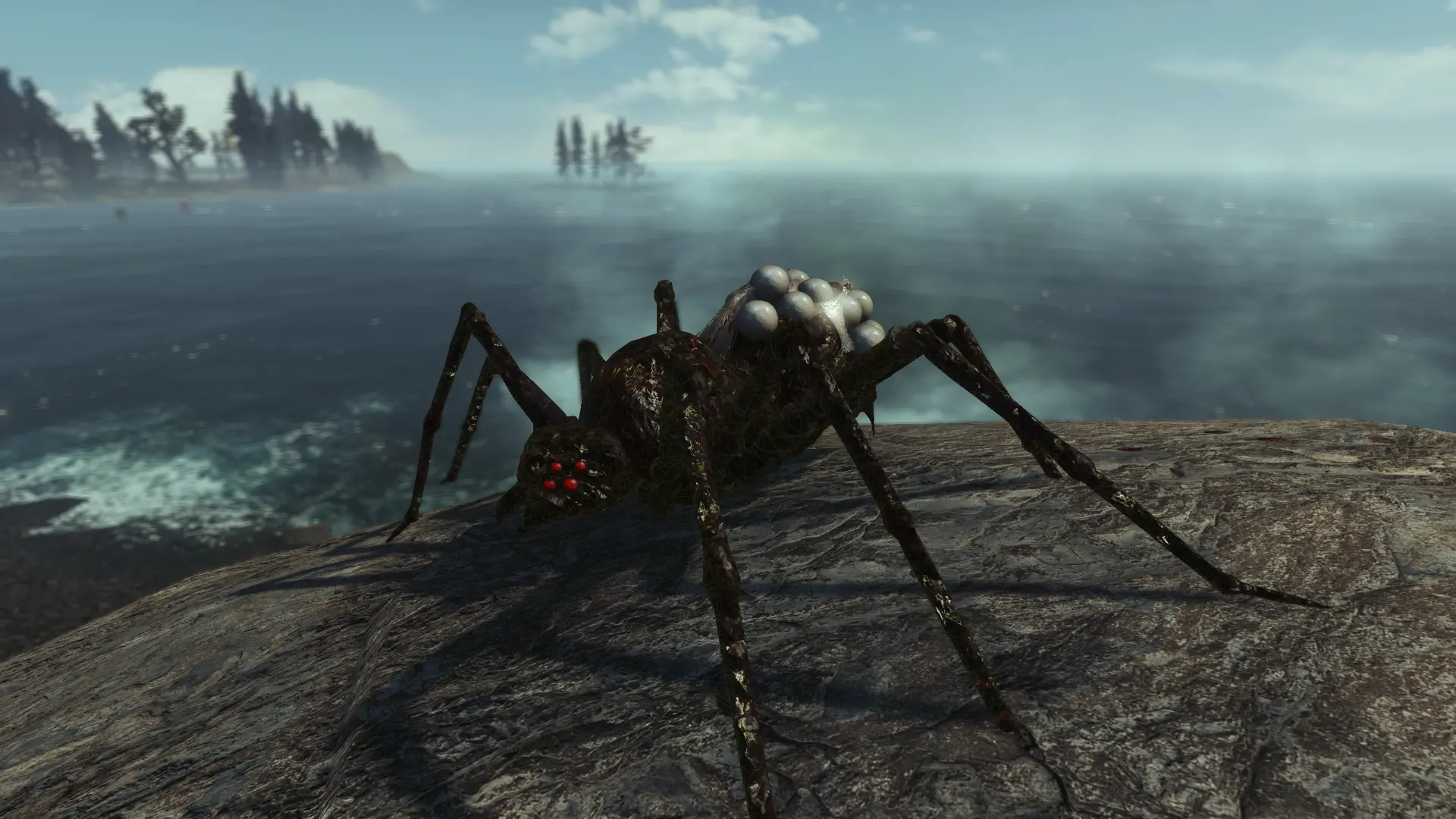
Radrachnids, previously one of the most problematic models, now fit entirely within the collision mesh of their source rigs - radscorpions. Additionally, they sport much more detailed textures and greatly-improved materials.
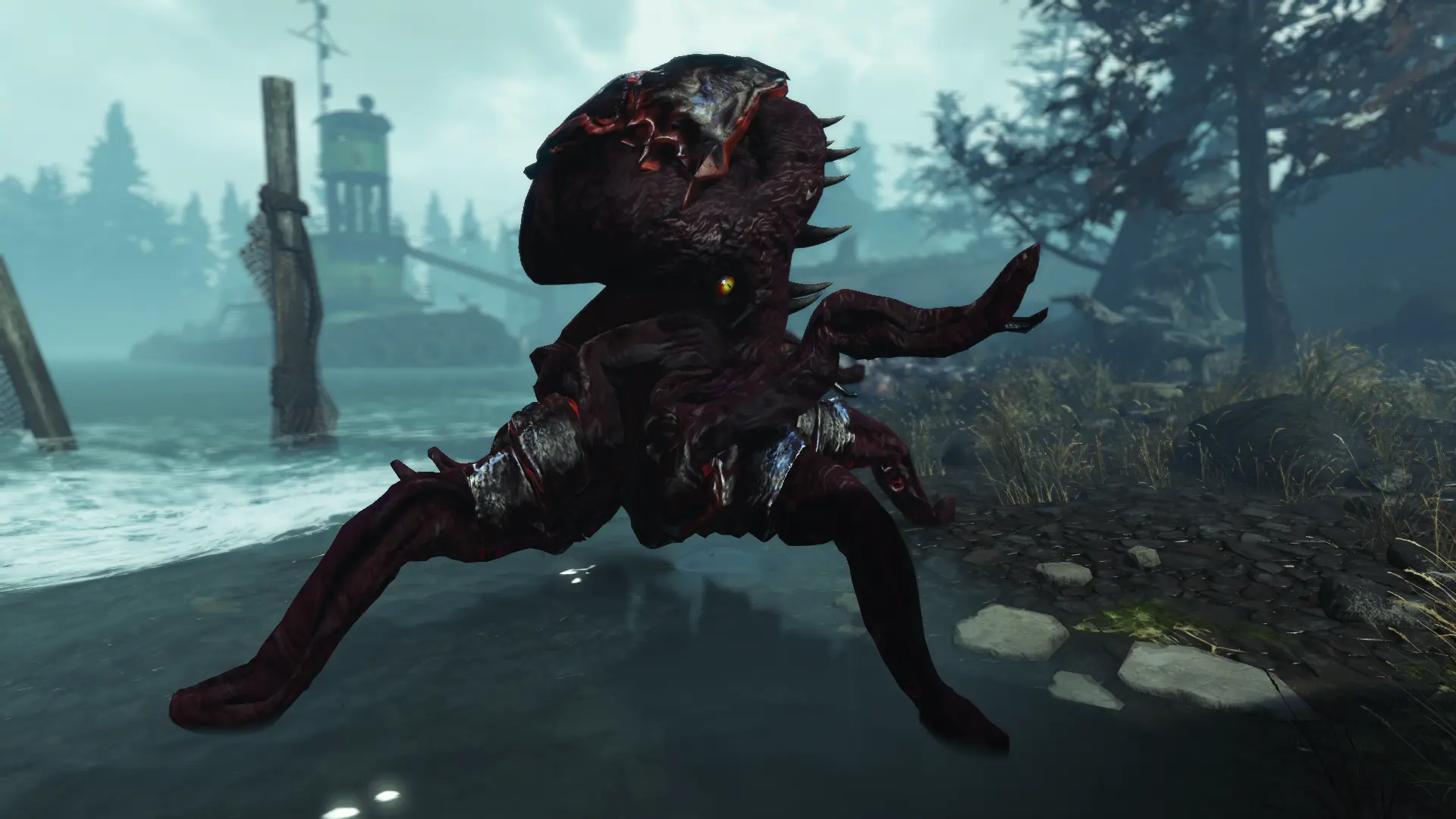
Improvements even come to alien creatures like the Kraken - which now features improved textures, materials, and a mesh that largely matches the collision model.
Aquaculture
Another exciting addition to Mutant Menagerie is a new system based on developments in rigging static actors. So, as it turns out, you can use Outfitstudio to rig anything - animated static objects included. While I was unable to use this to properly rig parrots to vanilla crow animations for Nuclear Safari (the way their wings stretched and folded was pure nightmare fuel, thanks for asking), I was able to use it for rigging up fish using the Far Harbor fish animobjects. And when I discovered this, I entered a bit of a frenzy. A frenzy that involved rigging more than 50 species of fish. And in the final expansion, the waters of Fallout 4 will be full of completely new, fully-animated fish of all shapes and sizes - all of which are either native or invasive species to the Commonwealth of Massachusetts (seriously, I did a lot of research).
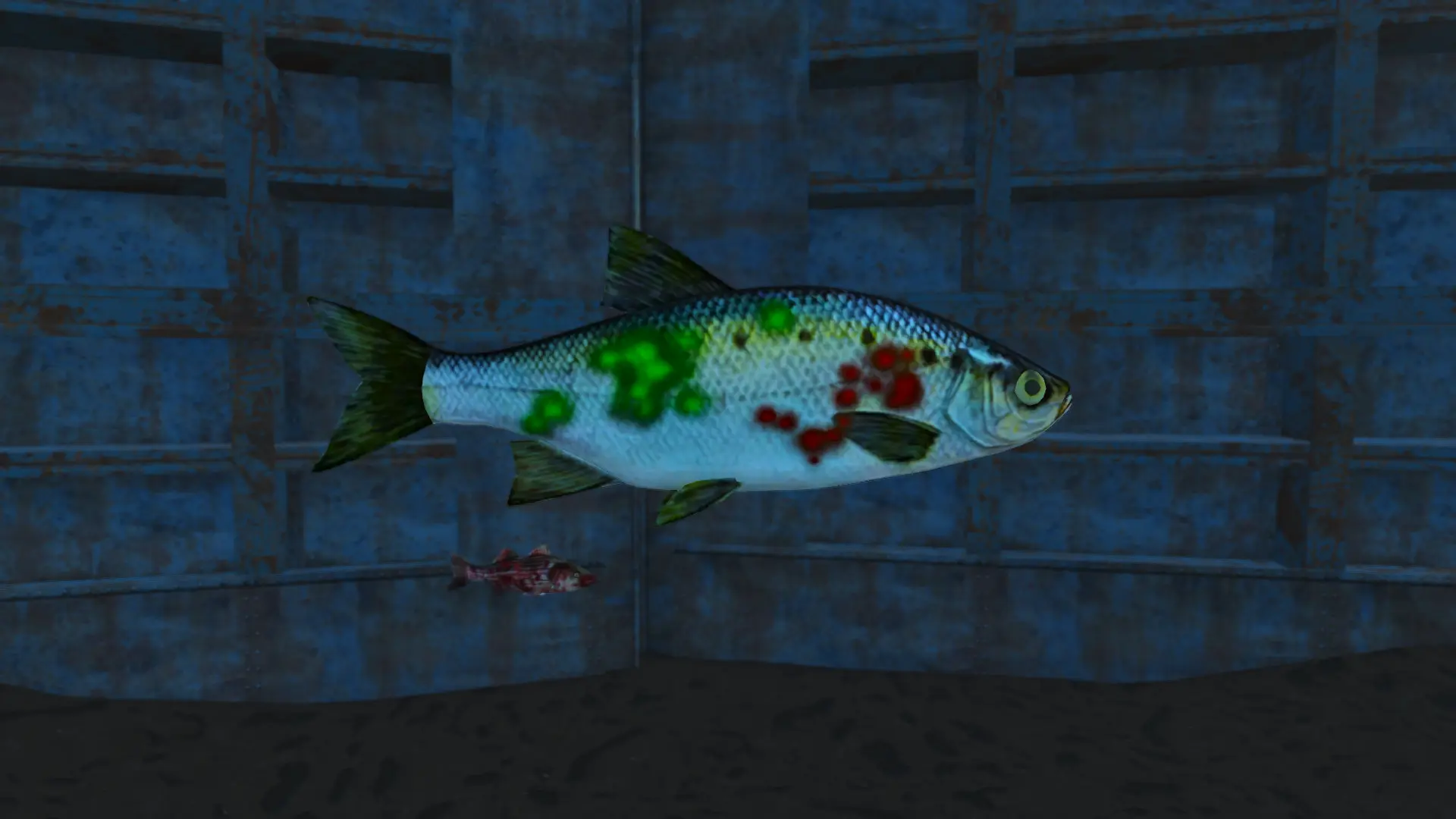
American Shad were one of 3 fish that appeared in Mutant Menagerie in its initial release. Then just a thrown-together reskin and remesh of the existing mackerel model, it now sports its own, brand-new assets. It still features the red blisters and green pustules of my original design, too!
All these new fish will swim the waters you'd expect to find them - hand-placed throughout the entirety of the Commonwealth. And, believe it or not, they're not just eye candy! Like in Skyrim, all of the new fish are interactive. You can swim the waters of Fallout 4 attempting to grab fish and harvest fish meat. When you attempt to harvest a fish, a dice roll will determine whether you get meat from your attempt. Larger, rarer fish are harder to grab, but will yield more meat! Explore the winding rivers and vast oceans of Fallout 4, and harvest the bounties of the sea - by hand! And, in doing so, you may stumble upon rare sights - like a giant bluefin tuna, an elusive Atlantic sturgeon, or even a mighty swordfish! The models are all suitably optimized to Fallout 4 standards. Low-poly models and modest textures ensure that the wide variety of marine wildlife doesn't impact performance.
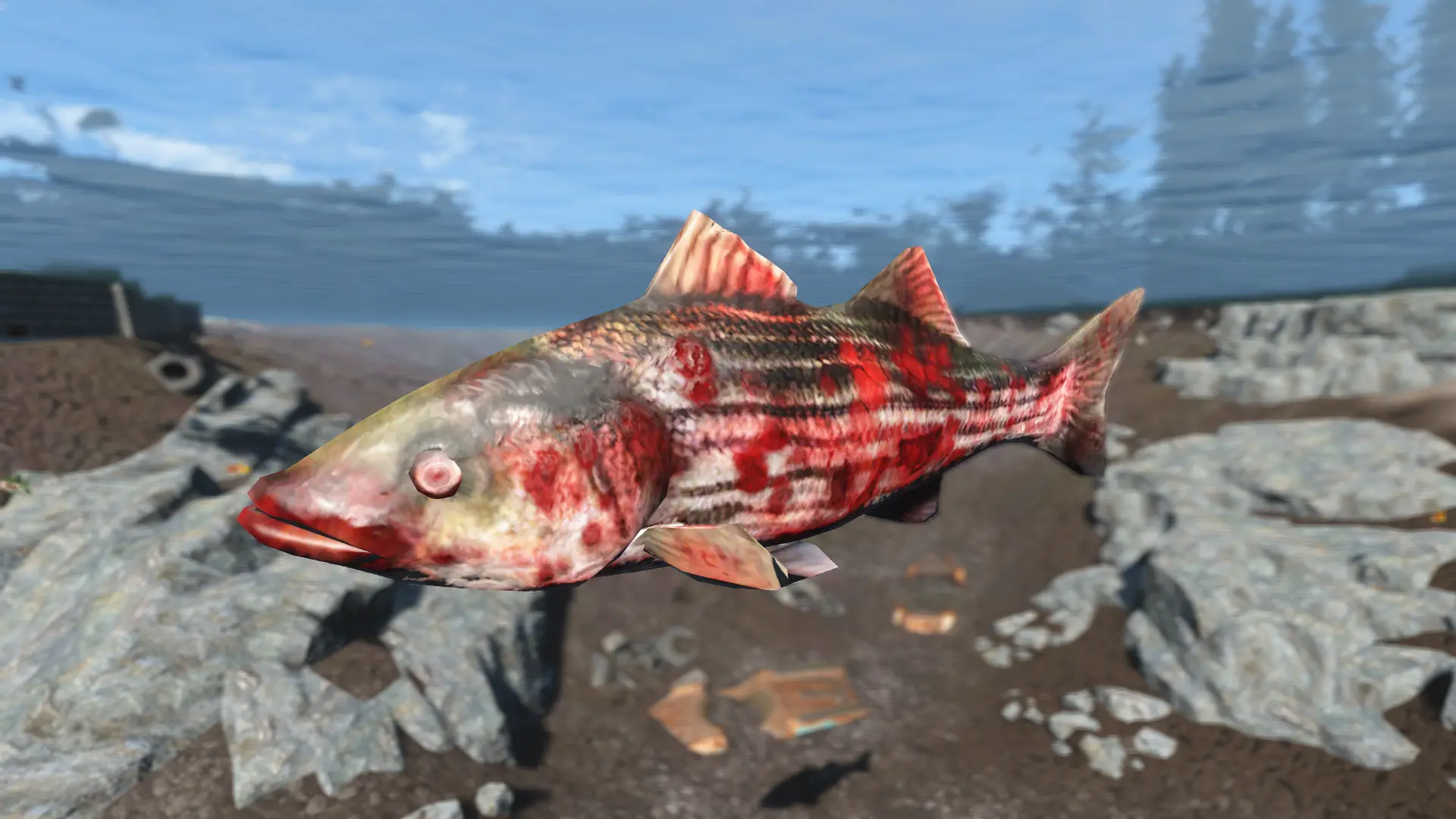
An irradiated striped bass swims through one of the Commonwealth's rivers.

An Atlantic Sturgeon roams the bottom of the Atlantic Ocean.
But that's not it - not even close! I've supported Commonwealth Fishing for a very long time through patches, but I've always wanted to do my own take on a fishing system. So, I took all these new assets, and the fishing animations released by Kinggath and Seebo and implemented into the CK by FlashyJoeR, and got to work. Like Commonwealth Fishing, you craft a fishing rod and stand in water to fish. Unlike Commonwealth Fishing, there is now a bait system. You must craft bait, use the bait, and then are allotted an amount of time to fish before the effect of the bait wears off. There are multiple types and tiers of bait that you can craft - with higher quality bait yielding longer fishing times.

In addition to the bait system, there are different categories and tiers of fishing rods, each of which are used to catch different types of fish. This includes both saltwater and freshwater angling. Higher tiers of rods also increase your odds of catching fish, or of catching junk if you don't catch a fish. Each rod looks different visually as well, and the different rod variants will show up in the animations. High tier fishing rods have specific perk requirements you must meet to craft them, meaning you will not likely be able to access the best rods right off the bat. If you're thinking that this must be yet another form of progression for Mutant Menagerie, then you're spot on! The real progression with this fishing system is reflected in the… er.. fish! Like I said before, there are more than 50 species of fish coming to Mutant Menagerie - and you can catch all of them. Each of these fish have variants as well - such as irradiated variants or diseased variants. Each of these variants come with visual differences, too. All fish can be butchered for their meat and other components. Additionally, fish can also be taxidermized and mounted - similar to the creature trophies I mentioned earlier. From creek chubs to Atlantic salmon, there is so much out there to catch.

A small sample of the variety held within the vast new fishing system.
Since this fishing system doesn't use any of the assets from Commonwealth Fishing aside from the fishing animation (which is converted from a modder’s resource anyway, according to the mod page credits), I hope to include this in the mod as part of the main package. Otherwise, it will - at most - require Commonwealth Fishing. The actual animated fish themselves will appear in Mutant Menagerie - regardless of whether this fishing system is included in the main mod or as an optional add-on.
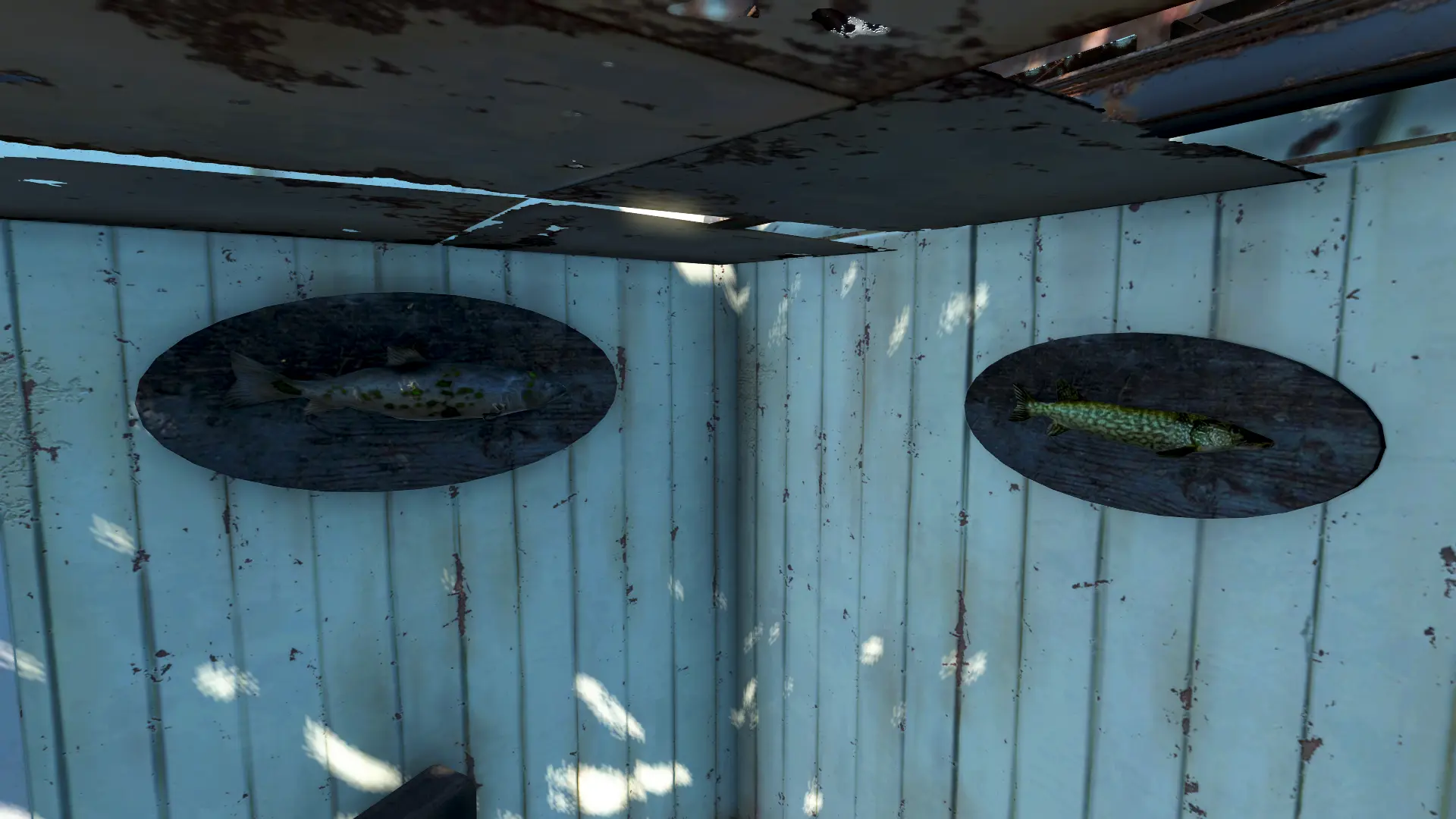
As stated in the above taxidermy section, the fish you catch can be mounted on the walls of your home or settlement! Build a true fishing lodge and display your catches to the world.
Foraging I: Holistic Wasteland Medicine
What exactly does the phrase "Mutant" mean in Mutant Menagerie? Are we relegated to just animals and creatures? Well, if you're lame and boring, you probably just answered "Yes, stay in your lane" in your boring, uninteresting little head. Now, if you're a cool cat, you may be wondering what I'm getting at in an optimistic and non-apprehensive manner. And kudos to you.
Mutant plants, and the classic Fallout concept of sci-fi pseudo-alchemy, are incredibly underwhelming in Fallout 4. I've always loved the way Fallout introduces consumables with potion-like properties through the mutant flora of the world, while still including some real-world plants that adhere to their real-world properties - albeit in ways that are cleverly translated into the RPG world of embellishment and exaggeration. I've also been around enough to watch Fallout actually struggle with its place on this rather-dichotomous spectrum as well - as I'm sure many of you have as well.
Fallout: New Vegas, despite being one of the greatest examples of survival-style alchemical crafting in the franchise, struggled heavily, in my opinion, with its portrayal of post-apocalyptic flora. While it included fantastical Fallout staples like xander root and mutfruit, most flora in New Vegas were just slightly irradiated and largely unmutated real-world herbs and spices. They were region-accurate, well researched, and entirely uninteresting. It's realistic worldbuilding, but it's not fun worldbuilding. This always struck me as odd, since New Vegas - from a worldbuilding standpoint - knocked it out of the park in every single other aspect.

Fallout: New Vegas has one of the best alchemy/crafting systems of any Fallout RPG or Bethesda game, but the ingredients themselves are a tad boring.
Fallout 76, on the other hand, sits far on the opposite spectrum. Its mutant fauna is far too zany and cartoonish, with very little thought or worldbuilding worked in. While its abundance of mutant flora is appreciated from a mechanical perspective, and it's crafting system related to flora is robust, the flora itself avoids the realism side of the Fallout flora balancing act entirely.
Firecracker berries literally exploding into fireworks when you pass by, for example, does more to wreck immersion than it does to reinforce the idea of a living, breathing world. Also, the idea that you have entirely unmutated blackberries and cranberries alongside starlight berries and firecracker berries feels a bit messy. Especially when, when it comes to wildlife, everything has been visibly affected by the nuclear fallout of the Great War in some way. It's just messy worldbuilding, with very little in-game lore or writing to back it up.

Fallout 76 has many unique and interesting ingredients - like the Firecaps shown above - and a vast crafting system. But some of the options are a bit too cartoonish and dissonance shattering.
A spectrum of mutation in Fallout should be well-documented and clearly thought out. And when you finally factor in the nuke-zone flora present in the game, things get even more confusing. It all screams "just turn your brain off and don't think too hard about it." And we all know that such statements largely go against the wider philosophy of the Fallout franchise's worldbuilding. Even when Fallout clearly states "this specific thing is cartoonish pseudoscience," the world typically endeavors to explain that element of itself in an engaging, interesting way (the lore behind energy weapons or many of the mutant creatures are great examples of this).
So, why the wordy preamble about plants? Because Mutant Menagerie is coming in hot with all-new harvestable flora, baby! That's right, to bolster the new recipe system expansion, and the world-exploration MM seeks to promote, an entire swath of new flora will be added to the world for wasteland foragers to find and harvest. Much of this flora appears in, or is inspired by, previous Fallout games. All flora will fit the game region, and should help to enhance immersion for Fallout 4's Commonwealth.
A huge goal with this system is to improve on the worldbuilding issues I mentioned above, while fixing Fallout 4's lackluster ingredients system. These new additions are being treated with the same care as all other mutants in the mod, because lore is very important to me - personally. Every new ingredient has a history, a purpose, and clear justification for its presence in the world. They should also add just a bit more color to the vanilla, washed out autumnal wasteland of Fallout 4 in the same way the mutant creatures of Mutant Menagerie do.
Foraging II: Garden of Atom
The all-new flora system includes around 20 totally new types of plants, and even more variations of existing flora. More specifically, the flora system adds mutant variants of vanilla flora - based on those found in nuke zones in Fallout 76. These variants are found primarily in the Glowing Sea, and are used for high-tier crafting recipes. To address aforementioned gripes with Fallout 76's flora systems, only flora that isn't heavily mutated possess these variations. For example, you won't encounter more-glowy glowing fungus, or blightier bight. And unlike in 76, these new herb variants don't exist just to provide flux - you actually get to keep the cool, glowing flowers.
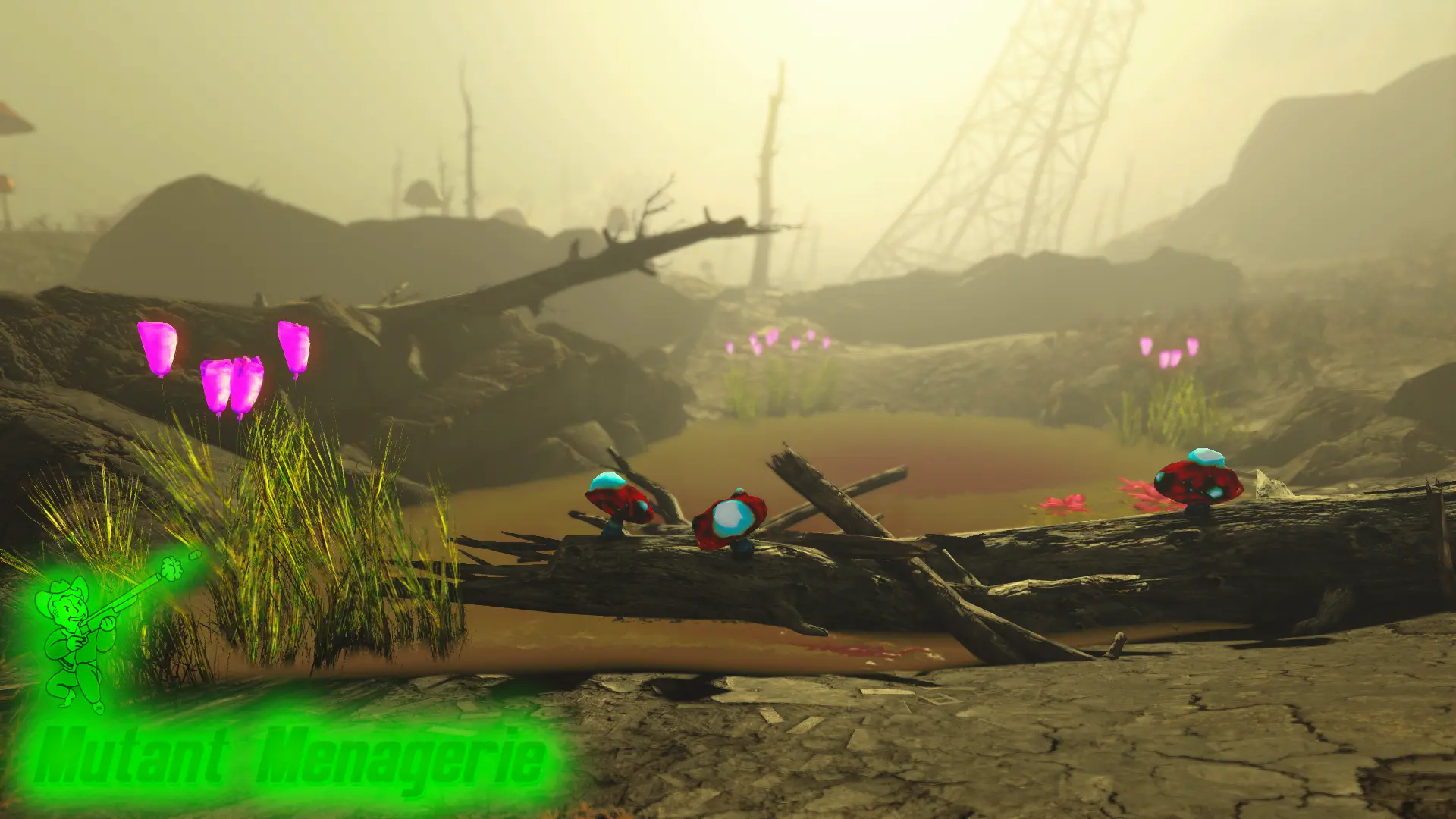
New, hyper-mutated flora adds to the otherworldly atmosphere of the Glowing Sea! They also act as high quality crafting ingredients for the purposes of Mutant Menagerie's crafting system. Some of these rare plants will spawn in the Deep Fog as well - including the Far Harbor-exclusive Red Hot Bloom.
As for the new flora, many of the new plants are from, or based on, other Fallouts. Most of the inspiration comes from Fallout New Vegas and Fallout 76, with consideration given to the benefits and flaws of each game's flora and harvesting systems mentioned in the previous section. The goal was to strike a balance between real-world flora inspired by the Boston area and its history and the wider Fallout franchise and its penchant for zany, yet immersive worldbuilding. Some of the odder flora recreated from Fallout 76, for example, have been toned down. Cracker berries, a recreation of firecracker berries, make a return - without including the ridiculous trap-explosion into LITERAL FIREWORKS. They're still volatile, which plays into their use in the crafting system, but they aren't… that.
On the other hand, some flora is entirely unmutated - like the all-new beach plums. These fruit-bearing bushes are found on coastal beaches and dunes, accurate to the real-life beach plums of Massachusetts. The radiation has clearly taken its toll, but the plant is relatively unchanged. Think of this as the plant equivalent to say, the foxes from Mutant Menagerie.

Beach Plums are found exclusively amongst sandy dunes along the coast. These plants epitomize the coastal New England atmosphere found in Fallout 4 - cool, grainy beaches spackled with thickets of brambles and shrubbery.
Additionally, some of the flora has evolved into something totally new as a result of 200 years of nuclear fallout and toxic waste. These plants act as a middle-ground between New Vegas's low-mutation flora and Fallout 76's "everything glows" flora. A great example of this is the all-new Lagonut Tree. These tall, moss-green bushes grow in marshes, and yield nuts comparable in size to coconuts. They are the result of hazelnut bushes being exposed to 200 years of both Glowing Sea radiation and the toxic waste and chemicals present in the brackish marsh waters - resulting in a sort of radio-gigantism. That's right, we have giant hazelnuts. See, the post-apocalypse isn't all bad after all!

Lagonuts - giant mutant hazelnut plants - can be found throughout the marshlands of the Commonwealth.
Of course, Mutant Menagerie wouldn't be Mutant Menagerie without something a little more - out there - in terms of design concept. Which is why you'll also encounter things like the extremely rare Honeybeast Bush - a hulking, jungley mass of orange flowers and yellow leaves that is both based on a region-native plant, and inspired by the massive spore trees of Fallout 76's cranberry bog. This huge bush emanates a sweet, intoxicating aroma that partially contributes to its namesake. Like its pre-war predecessor, butterfly weed, this massive bush is a favorite of insects - especially the mutant bees that pollinate it. In fact, it's hypothesized that pollination by the mutant bees may play a major role in the transformation of butterfly weed into honeybeast bushes. As you may have guessed, this means that honeybeasts are often found near these plants, and will protect defend them with a near-zealous vitriol.
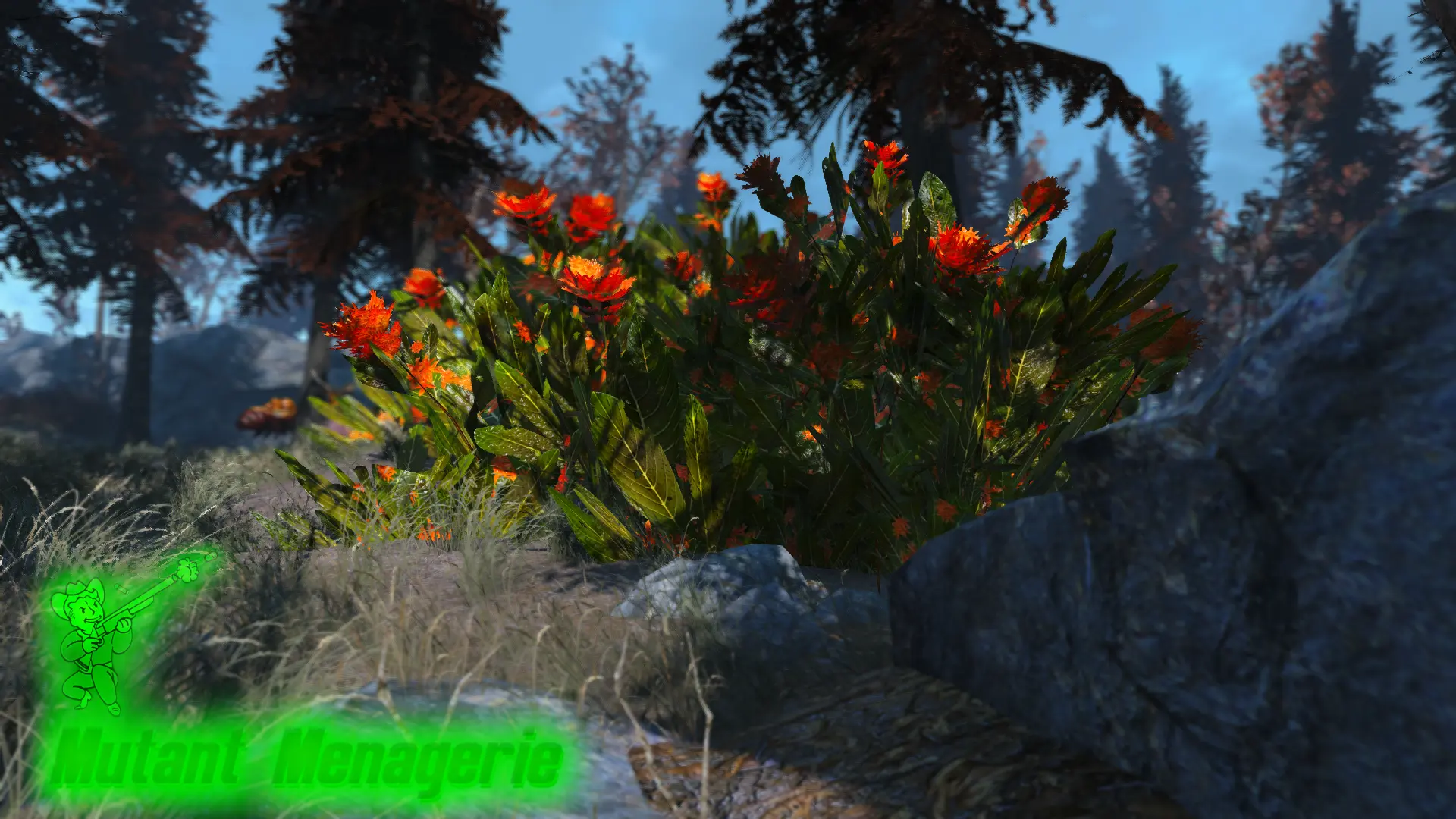
The Honeybeast Bush is yet another example of a native plant becoming wildly mutated. Through a mysterious process that may include pollination by honeybeasts and mutant bees, these extremely rare towering, flowering giants will very rarely sprout up in the wasteland wilderness. Their aromatic, sweet-tasting orange flowers are a prized delicacy - if you can escape the buzzing brutes that guard them.
Recipes Expanded I: Thesis Statement and Design Philosophy
To really break down my development process on the recipe system, I'm going to have to get in-depth about the concepts of criticism and how I designed and redesigned elements of this system based on feedback. This is all, obviously, going to be a bit pretentious, exaggerated, and oozing with hyperbole. The intent is, of course, not to offend anyone. If I step on your toes or criticize your views or opinions in the text block below, please keep in mind that your views, opinions, and experiences are valid! Just because we may not see eye-to-eye, does not mean I hold any ire for you or your beliefs. This is simply about mod development, and a big part of development this late in the game is how I interpret feedback.
One of Mutant Menagerie's more controversial features has always been its expansion on the crafting system for the vanilla game. When I say controversial, I'm really only talking about a minority of the user base, so it's a bit of a hyperbolic statement. The complaints I get generally include something along the lines of:
- "The new recipes are overpowered." (valid criticism)
- "The requirements to craft the new recipes are difficult/complicated/frustrating." (part valid criticism, part subjective preference)
- "Why can't this mod JUST be creatures?" (subjective preference)
Aside from the first complaint, I find elements of these comments to be questionable. They're less criticisms about the mod itself, and more the disclosure of contrasting opinions and preferences. Proper criticism, in my opinion, isn't "this isn't how I would have done it" or "this isn't to my tastes." To be frank, I don't really value comments that feign criticism while essentially amounting to "My issue is the mod wasn't made by me." You're entitled to an opinion, but an opinion isn't necessarily valid criticism. Additionally, in my opinion, authorial intent is more important than fan preference when it comes to a free, non-commercial project that the author isn't even getting paid for in any official, sustainable capacity. If this were a commercial product and I was part of a business, this type of subjective input from fans (especially those with a financial stake in the product) would be more crucial. But we aren't talking about the ebb and flow of a market economy here - we're talking about a free mod that, legally, qualifies as something closer to copyright infringement and cannot even be owned by anyone but Bethesda and Zenimax in the eyes of the law.
Now that that's all cleared up, let's talk about what I define as valid critique. Valid criticism analyzes the present content to determine its quality on an objective, unbiased level. Valid criticism does not speculate on how something should/could be - especially according to your subjective preferences. That's more of a thesis statement - the type of things our favorite, overly-hyperbolic YouTube creators put in the intro of an hours-long video essay to grab our attention, and reiterate at its conclusion. Criticisms that judge the mod based on authorial intent and execution, however, especially while drawing comparisons to the content found in the vanilla game, are the types of critiques I take very seriously. And in that, the community has been especially helpful. A lot of insightful individuals have hopped in my comment sections with the type of mathematical, data-informed critiques that can only be gathered from weeks+ of dedicated gameplay.
The consensus among this feedback, I found, was that the expansion on recipes was well-received overall, but the new tiers of consumables outclassed the vanilla items in a way that didn't feel rewarding. They were almost well executed, but could feel like cheating due to a mix of statistical over-tuning on my part, and the fact that, with a fair bit of knowledge about the mod, you could acquire some of the most powerful items quite early in the game. And while I think systems that can be gamed by smart/experienced players are cornerstones of good RPGs, there needs to be some level of guard railing. And because the components system of Fallout 4 and the hunting system were intrinsically connected, this exploitation also bled into the game's other crafting systems. You could, essentially, farm a cubic hyuck-ton of rare components if you knew the mod well enough.
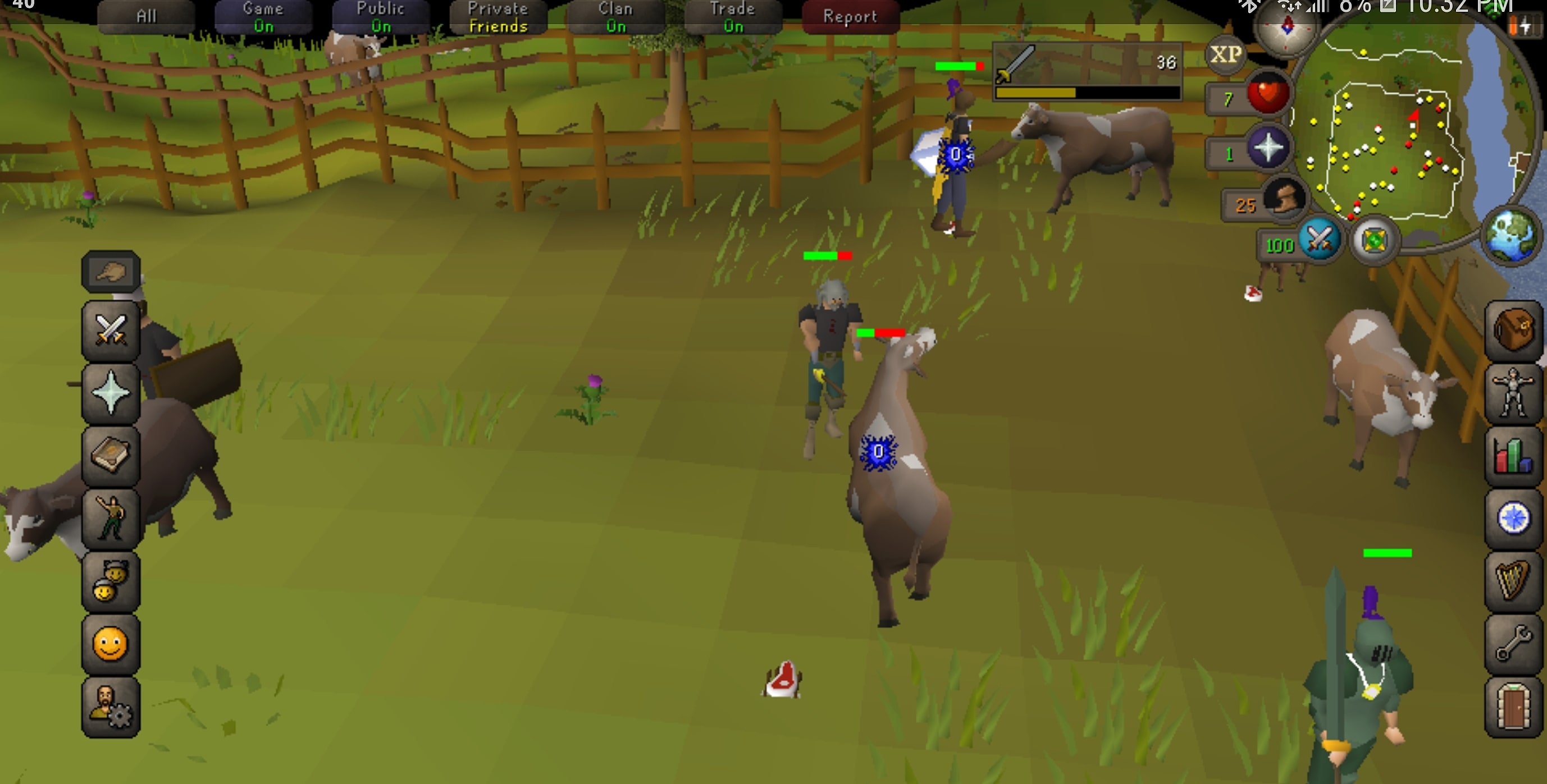
Believe it or not, Runescape was and is a major inspiration for the design of Mutant Menagerie's leveled lists. Now more than ever, understanding the nuances of complex RNG loot systems from games like OSRS have proven helpful in tackling the issue of loot balance in Mutant Menagerie's leveled lists.
The name of the game here is power creep. The recipe system had a power creep problem. Loot from creatures was more bountiful than vanilla. Items were worth marginally more, weighed significantly less, and could craft more powerful food items in a way that outclassed perk-locked consumables from vanilla Fallout 4. To be clear, I don't think power creep is as dirty a word as a lot of other people I know. Games-as-a-service style business models in video games, TTRPGs, and TCGs have made the concept of long-term power creep a sort of gaming boogeyman. But in classic sandbox RPGs or CRPGs, using a deliberate implementation of power creep can actually be a fantastic and engaging way to build a sense of accomplishment and progression. Items and features getting more powerful as you play, building to a climax of truly game-breaking rewards in the endgame - just the thought alone causes my serotonin cannons to fire off. And it's a big part of the reason why I think both Soulsborne and Rougelite games can be so addictive (in a good way, of course.) As you play, the power creep keeps things interesting, eventually culminating with a point where the player truly feels like a golden god. This power fantasy is ruined, however, if a feeling of cheating or spoon-feeding enters the formula. Basically, good implementation of gameplay system that features power creep is one that doesn't shatter the veneer of verisimilitude that the game works hard to build.

Games like Elden Ring expertly display how it's okay to slowly take an underpowered protagonist, and build them into an overpowered killing machine over the course of the game - all while maintaining the challenge and feeling of earned progression.
Mutant Menagerie was never intended to be just about the mutants. It was always intended to expand the crafting system and add new paths and progression to Fallout 4. The original systems by which Mutant Menagerie was inspired - the hunting systems in both the Far Cry and Red Dead Redemption franchises - were each present as ways to facilitate crafting/reward systems. The intent was to take a concept like Beasts of Tamriel for Skyrim or Monster Mod for New Vegas, and fuse it with the systems from the aforementioned franchises. Additionally, if there was nothing interesting to do with the new creatures aside from killing them, the mod would get old and uninteresting after a few hours. Vanilla Fallout 4 is a prime example of this, actually. Each creature you kill drops meat and maybe a crafting component - usually one with very little value. And as a result, fighting humans is usually far more rewarding and interesting. I doubt any player is ever excited to clear out a mirelurk den when all they get as a reward is a dozen pounds of mirelurk meat and a basic 'end-of-dungeon' steamer trunk.
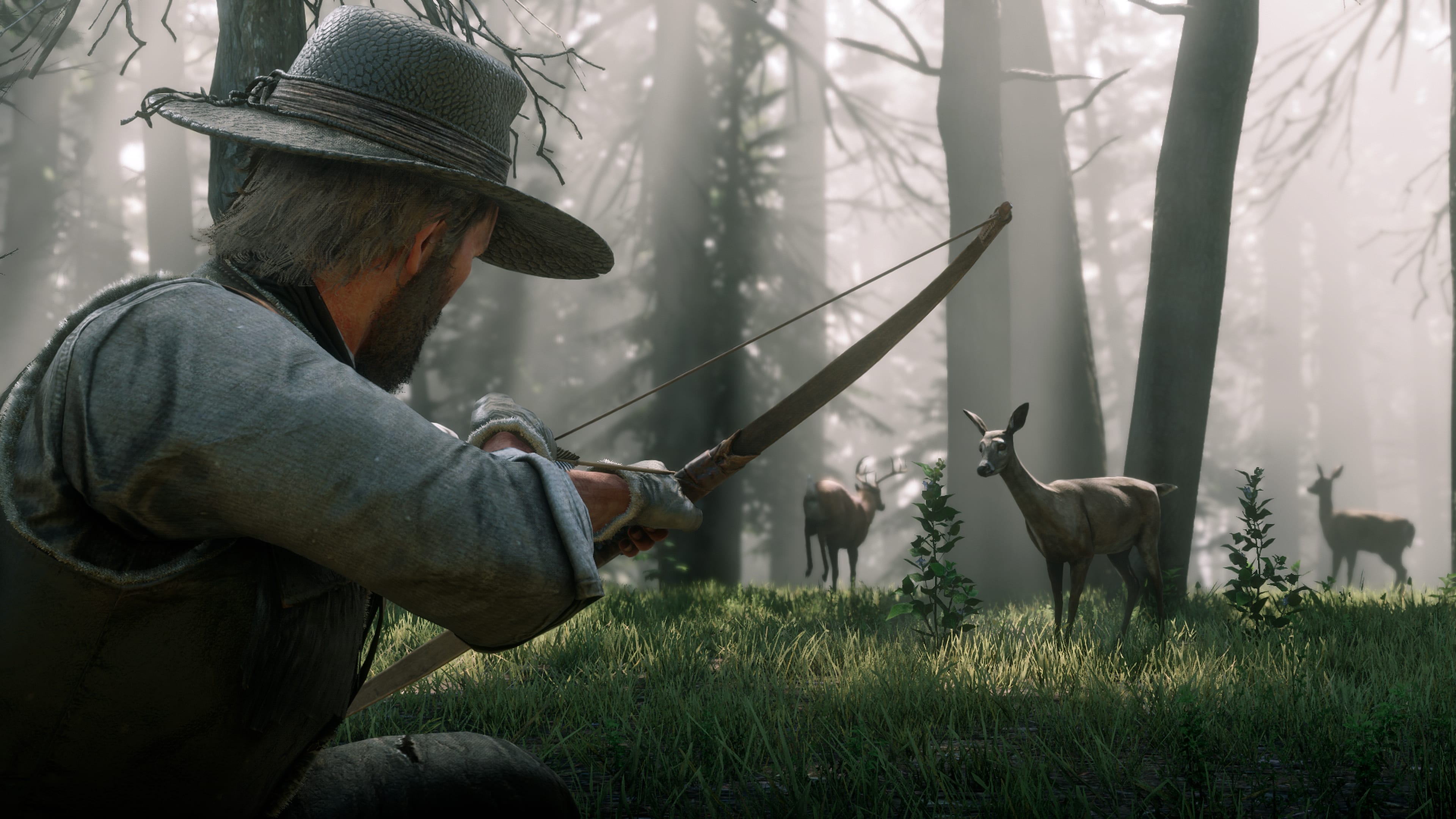
If you disagree with this take, that's totally fine - this is, after all, just my personal view. We probably wouldn't get along social gatherings, but that's okay. The intent with Mutant Menagerie was to correct what I perceived as a core issue with the game. I wanted to expand the recipe system to offer a wide variety of craftable items that the player would actually find useful. I also wanted recipes that challenged the player. In the base game, crafting recipes are really "baby's first crafting system" levels of watered-down. Most cooking recipes amount to 2 pieces of meat, and maybe an herb. Very few perk requirements, very little depth, just easy recipes that allow the player to mash the a button for a few seconds and get high on the dopamine as the XP rolls in.
Recipes Expanded II: Rebalance, Scarcity, and Power Creep (But in a Good Way)
In order to expand on the recipe and crafting system for Mutant Menagerie to truly amount to a systematic overhaul for cooking and item crafting, I needed to adjust the issues of game imbalance and power creep within my existing system. So, I started with a full sweep on balancing throughout the mod. From creatures and their stats to leveled lists and loot, everything was on the list - and I've checked it far more than twice. I've made substantial overhauls to make the mod far less polarizing towards vanilla balance in terms of gameplay balance and loot economy, and I'll keep doing balance passes throughout the expansion's development. The goal here was to build a faux-Runescape style system for Mutant Menagerie's loot economy. There are rare drops, extremely rare drops, and drops you may never see. On the surface, a creature's drops will look nearly identical to a vanilla creature's - meat, a junk item or two, and maybe a pelt or hide. Rare items, by and large, only have a 15% drop rate even on high-level/quality creatures. From there, items only get rarer in terms of drop likelihood. Some extremely rare items in shared drop lists are leveled, meaning you won't start seeing them until you reach a certain level in your playthrough. This means the only creatures that will drop veritable mountains of loot on death are the World Bosses - which is the whole point of a World Boss anyway.

The loot pools of most Mutant Menagerie creatures are now far more reasonable. They still have depth and a wide variety of possibilities, but you're unlikely to get more than 3 loot items on average - 2 of which are usually meat and a hide.
In addition to the likelihood of items, the actually items themselves have seen rebalancing as well. Meat items have had their weight and value reigned in to match vanilla. Hides and junk items have had seen similar changes, and have had their component yields drastically nerfed. Especially rare components have been culled across the board, ensuring that you won't receive mounts of oil, adhesive, and nuclear material from hunting. The goal was to keep the original concept of making loot more unique and ensuring you could supplement scavenging with hunting, but keep the overall loot economy vanilla-adjacent. For food items, all the base rebalancing has been performed as well - including weight, value, and recipe adjustments. Effects for more tempered items has been completed as well, making more overpowered effects less so. The best items will still be nominally better than vanilla items, and be more complex to craft. However, this is now balanced out by their perk requirements - since the vast majority of food items require one or more of Mutant Menagerie's perks. Items are split into tiers, and different tiers of items are unlocked through acquisition of the mod's various perks. This gates the intentionally OP recipes in such a way that guarantees they will not become available until you've put in the necessary amount of work to earn them. And since the recipes themselves are quite complex, you may still have to put in work to acquire all the ingredients even after you DO acquire them!

Most loot and food items, both new and old, now sport either new or modified assets. All of these assets have proper collision too - copied from other items of similar shapes and sizes from the vanilla game.
The end result is, I hope, a system that carefully weaves the mod's power creep into a slow burn that maintains the verisimilitude and overall logic of a Bethesda game loot economy. It takes the ideas that are there, and levels them up.
Recipes Expanded III: Master Chef
So, with Mutant Menagerie and its expansions, I heavily expanded on crafting - primarily on the cooking side (where depth was desperately needed most). With the final expansion, this system has been fully expanded to a complete and final level.
Using the new perks as a base, most recipes from Mutant Menagerie are now progression locked. Secondary perk requirements often utilize lesser-used perks - to give more value to those vanilla perks. I fondly remember a user commenting on the mod page about this design choice, complaining that they had to go "off-build" to craft all the new Mutant Menagerie recipes. I say fondly because, well, that's quite literally the entire whole point. And if you manage to irritate someone who identifies as counter to your intent and philosophy, then you're on the right track!

The new raw food assets are designed to look gorier - like meat ripped straight from a corpse!
The new perk requirements are also a great way of gating off the intentionally overpowered recipes until late game. Players won't be able to access endgame items until they have played enough to have earned them. Combine this with the growth in recipe complexity and the larger rebalance to the mod at large, and I think players will find the recipe system far more agreeable this time around.

Even the simple cooked variants of food items will come with unique looks. The devil is in the details!
In addition to reworking the system at large, new recipes will be available en masse in the last expansion. I've always intended to dedicate an extensive period of time to a full expansion of the recipe system, but that time never came. Now, I'm devoting a significant period of Mutant Menagerie's development to new recipes. Unlike in the base mod, these new items come with new assets from various modder's resources and 3d model sharing platforms like Sketchfab. The goal here is to properly introduce a wide-variety of wasteland cooking recipes. Other mods get a bit gourmet for my taste, so the goal with Mutant Menagerie is to get grungy and rustic.

Many of the meat items from more conventional creature types now actually LOOK like they came from those creatures!
While many of these items are just for survival and sustenance, others are meant to prioritize unique effects. In my opinion, a good RPG utilizes "magic food." That is to say, consumables that introduce unique and interesting effects that - while thematic to the food item - aren't necessarily realistic. If you prefer realism in your RPGs, that's fine - different strokes for different folks. I've always viewed food magic in video games as a literal manifestation of a food's flavor and quality. For example, a very rich, filling food restores a high amount of health. Savory food might increase damage output, spicy food might provide fire resistance or enhance fire damage dealt. Games like The Legend of Zelda: Breath of the Wild, Red Dead Redemption 2, and - to an admittedly lesser extent - Witcher 3: The Wild Hunt do a great job with this. If you've played those games, you probably understand what I'm trying to do here.

Various new teas, juices, and alchemical mixtures can be crafted from the new flora found in Mutant Menagerie!
In the final version of Mutant Menagerie, I hope to really go all-in on these unique effects. There will always be minor survival items and much more effective endgame items, but now there will be an assortment of items with unique and interesting applications. The goal is to not go too far with these, and avoid stepping on the toes of the various chems and medical items already available in the game.
Recipes Expanded IV: Campfire Crafting
In addition to food, this recipe expansion will also build on the developments of the MM expansions. The expansions always added new equipment and unique weapons that could be crafted from the "Campfire Crafting" menu of the cooking station. The goal, as some may have picked up on, was to evoke the same tone as crafting survival skill based recipes by the campfire in Fallout: New Vegas. To me, that always felt far more Fallout than, well, jamming all of a mod's recipes in the Chemistry Station. I'm sorry, but what about beakers and test tubes says "universal crafting for everything from holotapes to military-grade weaponry?" Plopping down by a campfire or a hot stove and rigging up some handmade gear always just seemed much more natural to me, personally.

In the final update for Mutant Menagerie, homemade consumables like powders and poultices act like a wasteland equivalent to potions. Restorative Powder, pictured above, is statistically identical to Healing Powder from New Vegas. It, along with all of the other new powders, is unlocked via the new Mutant Menagerie perks, and scales with the vanilla Medic perk.
In Life Finds a Way, the Campfire Crafting section now feels like a fully realized section of the crafting system for Fallout 4. You'll be able to craft everything from powders, poultices, and remedies to deadly new weaponry. Everything is meant to use both vanilla and Mutant Menagerie ingredients and perks, adding more use for vanilla items while justifying the existence of Mutant Menagerie's creatures and loot.

The Handmade Spear is a new, early-game melee weapon the player can craft in the Campfire Crafting menu. While it starts off as a simple stone spear, it is highly modular, sporting more-than 20 possible upgrades. As you can see, the advanced upgrades can keep the weapon viable in the late game - especially when paired with the proper melee weapon perks.
The mod's tone is meant to carry through in all the new recipes. Everything in the final release is meant to feel hand-made, cobbled together, and fit for a wasteland survivalist. Like the new food items, many of these new craftable items will utilize new assets. They also feature expanded functionality in one way or another. The goal is that, when this expansion releases, there will be an entirely new system of progression for anyone looking to play a proper wasteland survivalist build. I've made sure to retroactively adjust many old items and recipes to match this design philosophy as well. This includes the old, unique rewards for Mutant Menagerie and its expansions. Most of these items now require recipes found in the world to craft, sport unique looks or new assets, and require at-least one Mutant Menagerie-specific perk to craft. Some of the equipment also sports additional new attachments.

Many of the existing Mutant Menagerie reward items are now visually distinct - like the Harborman's Aid shotgun. In its base form, it's little more than a level-upscaled double-barrel shotgun. It's weapon-specific upgrades, however, introduce more than just a unique texture set!

Dell Lincoln's Bestiary
The last feature I want to touch on in this development diary is the scavenger hunt/in-game lore system known as Dell Lincoln's bestiary. When you load into the game with Mutant Menagerie installed, a wealth of lore will be available to you to find in the world. Information on every unique mutant creature found in Fallout 4 and in Mutant Menagerie will be contained within the Bestiary, and its pages are scattered across the Commonwealth and DLC worldspaces. All of this lore was written and compiled by Dell Lincoln - a biologist, radiozoologist, and writer of the acclaimed series of books known as Mutant Menagerie! In his travels, Dell Lincoln has seen all manner of mutant montrosity, and he has compiled everything you need to know about them in his series of in-depth bestiaries.

The pages of the Mutant Menagerie book series are readable on their own, and able to be compiled into book-sized volumes. In addition to official bestiary entries, Dell Lincoln also leaves tales and journal entries behind for wayward travelers to discover. Anyone that follows his trail may uncover a mystery or two along the way, and be rewarded for doing so!

The final component of the Bestiary system is creature photographs! Dell Lincoln often leaves behind creature photographs alongside his bestiary entries. These pictures give you a glimpse of the creature or creatures in each entry, and may unlock some new recipes or bonuses upon collection! The entire Bestiary system is still a work-in-progress, but most of the photographs and lore entries have finally been finished. Implementation is well under way, and I hope to create something super fun and rewarding from both a story, game, and lore perspective once the system is finished!

If you made it all the way to the end, thanks for reading! These developer diaries have been a fun way to archive my progress over the last two years. My career as a mod author has been an incredible experience, due in no small part to Mutant Menagerie. It's crazy to think that this project I spent years working on alone in my room in secret has come so far. To me, this mod is something special. It's my own little slice of Fallout - my contribution to one of the coolest universes ever created. I have worked so hard to create something that feels authentic to the franchise, and it's finally nearing completion.
Now, as for the release window, I expect the mod to be out sometime this year. Since progress on this mod is largely a domino effect that relies on each chunk being completed to work on another, it has proven to be largely unpredictable. Problems pop up where I least expect, and other things go far smoother than I expected. This diary marks a halfway point of sorts, and that's all I can concretely say. But trust me, we're getting there.
To end off the diary, I'll drop one final sneak peak into the future of Mutant Menagerie, featuring something I've had planned since the mod's initial release:

If you want to support my work, you can do so by supporting my mods on their respective pages! I also accept donations through Nexus and BuyMeACoffee, if you want to help me keep the lights on! Lastly, if you somehow haven't gotten enough of my pretentious rambling, I recently did an interview with Shilohmc33 about modding, Starfield, and numerious other hot-button topics. So feel free to check it out if you're interested in my wider thoughts and opinions beyond Mutant Menagerie! That's all I got for you this time around.
- Justin, AKA Delicon20
